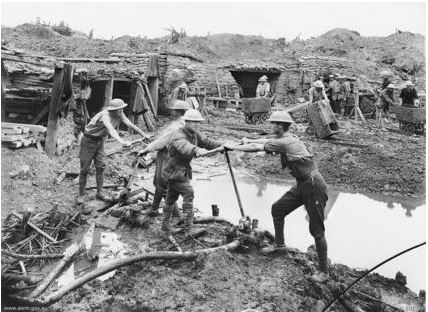1st Tunnelling Company
From Our Contribution
 | |
 AWM 01396 1st Tunelling Coy near Hooge | |
Brief History
The Australian Mining Corps was raised within the A.I.F. around August/September 1915. It is known that the manning of that unit specifically included a proportion of members from the mining industry and allowed enlistment up to the age of 50 to capture the experienced men the Corps would need to fulfil its role. About 38% of the men had been employed within the mining industry.
After a fairly short training period with British and Canadian Tunnelling Companies already in France, the Australian Companies were allotted to different Armies and assigned separate areas of responsibility. Their tasks were allocated by the General Officer Commanding the British Expeditionary Force through the Controller of Mines. Primary tasks of the Tunnelling Companies were the construction of tunnels and mines for offensive action against the enemy, detection and interruption of the enemy’s counter-mining efforts, and the construction of underground dugouts to accommodate large groups of men, in many cases whole battalions of 1,000 men including Battalion Headquarters.
The 1st Australian Tunnelling Company was formed in May 1916 from the Australian Mining Battalion which had been assembled from men with a background in civilian mining in early 1915 in Egypt with the intention of deployment at Gallipoli. Shortly after moving to France in May 1916 the battalion was split into the three Tunnelling Companies and one Special Company.
They relieved the British 175th Company RE in May 1916 in the Hooge area of the Ypres Salient. They took over the tunnels at Hill 60 on 9 Nov 1916 from the Canadians preparing the mines for the Battle of Messines and undertook work on the Catacombs inside Hill 63 at Ploegsteert. John Laffin’s Guide to Australian Battlefields of the Western Front describes Hill 60 as:...“One of the most famous positions on the Western Front , the hill had been formed in the 19th century from the spoil of a deep railway cutting.... The hill’s height of 60 metres gave it immense strategic importance in a flat country and both sides continually fought for it. Hill 60 was a spoil heap 230m long and 46m high, made from the cutting of the Ypres–Comines railway, and it formed a low rise on the crest of Messines Ridge on the southern flank.
For months the underground workings had been dug and re-dug, lost and recaptured, until finally with a tremendous charge of 123,500 pounds of explosive, the Australians blew the craters in the opening phase of the battle of Messines, on 7 June 1917. The result was particularly deadly, for the mine was stated by the Germans to have taken up with it a whole company of Wurtumbergers, and prepared the way for the advance of the British troops over this area.
Protecting the mines from the Germans involved the Diggers in ferocious underground fighting. The work was arduous and exhausting and six months’ service in the tunnels of Hill 60 was regarded as the limit of strain any troops could stand.
Unit personnel
- Thomas Hale Kensit 14 Mar 1917 - 26 Mar 1919
Individual Honours
Notes
Content for the history and honours sections has come from a combination of Wikipedia and the Australian War Memorial websites.
For further detail on the Tunnelling units during ww1, see:
- Crumos and Camouflets - Australian Tunnelling Companies on the Western Front by D Findlayson